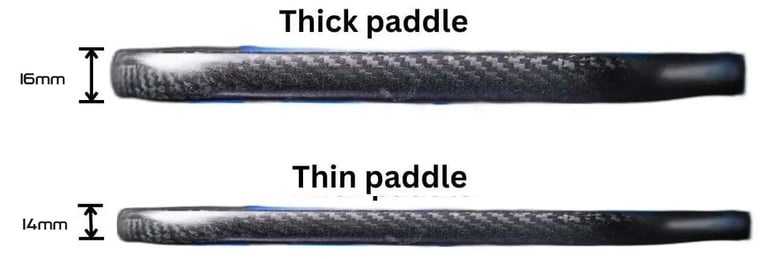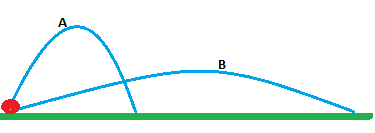
14mm vs 16mm Paddle
In today’s market the majority of paddle producers offer the exact same paddle in two different thicknesses most commonly a 16 mm and a 14 mm. Aside from the thickness of the paddle, these 2 paddles are identical with the exception that one is a little thicker and the other is a little thinner.
TECH CORNER
5/16/20226 min read


The first difference between thicker and thinner core paddles lies in their power and pop. A thicker core paddle tends to provide more power and pop, allowing players to hit the ball with greater force and generate more speed. On the other hand, a thinner core paddle may offer slightly less power and pop, but it can provide better control and precision in shots.
Control is another characteristic that sets apart thicker and thinner core paddles. Thicker core paddles generally offer more control, allowing players to have a better feel for the ball and make precise shots. Thinner core paddles, on the other hand, may sacrifice a bit of control for increased power, making them suitable for players who prefer a more aggressive playing style.
Forgiveness and twist weight are also factors to consider when comparing thicker and thinner core paddles. Thicker core paddles tend to have more forgiveness, meaning they can absorb more shock and vibrations from off-center hits, resulting in a more stable and comfortable feel. Thinner core paddles, on the other hand, may have a lower twist weight, making them easier to maneuver and rotate during shots.
Swing weight and static weight are two more characteristics that differentiate thicker and thinner core paddles. Thicker core paddles generally have a higher swing weight, which can provide more momentum and power in swings. Conversely, thinner core paddles tend to have a lower swing weight, making them easier to swing and maneuver. In terms of static weight, thicker core paddles may be slightly heavier, while thinner core paddles are usually lighter.
Spin is another aspect where thicker and thinner core paddles may differ. Thicker core paddles often offer more spin potential due to their increased power and surface area, allowing players to put more spin on the ball. Thinner core paddles, although they may not generate as much spin, can still provide decent spin capabilities, especially for players who rely on finesse and control.
Lastly, launch angles can vary between thicker and thinner core paddles. Thicker core paddles tend to provide a higher launch angle, allowing players to hit the ball with a higher trajectory. This can be advantageous for players who prefer a more defensive or lobbing style of play. Thinner core paddles, on the other hand, may offer a lower launch angle, which can be beneficial for players who prefer a flatter and more aggressive shot trajectory.
Power and Pop
When it comes to power and pop in table tennis, power refers to the ability of a player to generate speed with bigger swings, such as overhead serves and drives. On the other hand, pop refers to the amount of speed a player can generate with shorter swings, like counters or flicks at the net. From the baseline, there won't be a significant difference in power between a 14mm and 16mm paddle because the extra power of the 14mm is balanced out by the extra weight of the 16mm. However, if both paddles had the same weight, the 14mm paddle would provide more power.
The real difference between the two paddle thicknesses becomes apparent when you're at the net. With a 14mm paddle, you'll experience more pop and a greater jump off the face when countering balls or speeding up your shots. This means that players using a 14mm paddle will have a slight advantage in generating offense at the net. On the other hand, the 16mm paddle will absorb a bit more pace, making it slightly more suitable for defensive play at the net.
Control
The 16mm paddle offers a higher level of control compared to the 14mm paddle due to its extra material and thicker core. It excels in absorbing pace off the ball, making it easier to manage your shots during crucial moments on the court such as returning or neutralizing the ball, or when you find yourself under pressure from your opponents' attacks.
In contrast, the 14mm paddle is slightly bouncier and more reactive on the face, which can make it challenging to control the pace of the ball in certain situations. The 16mm paddle, on the other hand, provides a softer impact feel, making it more forgiving and user-friendly during gameplay.
While the 14mm paddle may offer more power at the net, the 16mm paddle shines in terms of control, shot placement, and the ability to dampen the pace of the ball when necessary. Many players prefer the softer feel of the 16mm paddle as it is often associated with improved control and precision on the court.
Forgiveness And Twist Weight
The concept of forgiveness in paddle sports refers to the paddle's ability to compensate for mishits or shots that are not perfectly centered. Essentially, it is the paddle's capacity to assist players in executing shots effectively, even when they don't hit the ball with the paddle's sweet spot. In simpler terms, forgiveness can be described as the size of the sweet spot on the paddle.
When it comes to measuring forgiveness, the thickness of the paddle plays a role. A paddle with a thickness of 16mm generally provides an average or above-average sweet spot. On the other hand, a paddle with a thickness of 14mm typically offers a slightly below-average sweet spot.
Now, let's shift our focus to twist weight. Twist weight refers to the paddle's resistance to turning about on the vertical axis. When comparing the twist weight measurements of a 14mm paddle and a 16mm paddle, you'll notice that the 14 mm paddle has a lower twist weight number. This means that the 14mm paddle is more resistant to turning compared to the 16mm paddle.
The reason behind this difference in twist weight is the amount of material present in each paddle. With more material in the 16mm paddle, it tends to be more stable and forgiving. As a result, it becomes a little easier to control compared to the 14mm paddle.
In practical terms, this means that if you find yourself stretched out or if you miss hitting the ball in the middle of the paddle, you are more likely to get the ball in play with a 16mm paddle compared to a 14mm paddle. The forgiveness provided by the larger sweet spot of the 16mm paddle increases the chances of successfully returning the ball even on mishits.
Weight
There are two different weights to consider when it comes to paddles: static weight and swing weight. Static weight is simply how much the paddle weighs when placed on a scale, while swing weight measures how heavy the paddle feels when you're swinging it during a game.
It is crucial to focus more on the swing weight rather than the static weight because swing weight provides a better indication of how the paddle will feel and perform on the court. For instance, the average swing weight for a 16mm paddle is 117.5, whereas for a 14mm paddle it is 112.
A lower swing weight suggests that the paddle will feel lighter and be easier to handle, making it more maneuverable. On the other hand, a higher swing weight indicates that the paddle will feel heavier and may be a bit slower to move around.
When comparing a 14mm paddle to a 16mm paddle, the 14mm paddle is likely to move through the air more smoothly, feel lighter in your hand, and have better maneuverability. This can be advantageous during quick exchanges at the net or when covering a lot of court space.
Having a lighter paddle, such as a 14mm, can be beneficial when you need to react quickly to incoming shots or when you're constantly moving the paddle around. Many players prefer a lighter paddle as it can feel more comfortable and easier to handle during gameplay.
Spin
In most cases, the spin rating tends to be slightly higher on a 14mm paddle compared to a 16mm one. Although the ratings are generally quite close for the same model with these two thickness options, the 14mm paddle does hold a slight advantage. The idea behind this is that with a slightly lighter paddle, players are able to accelerate their strokes more quickly, resulting in a greater ability to generate spin.


The launch angle also comes into play when speeding up balls off the bounce. For example, when attacking a ball that has a high trajectory after bouncing, using a 14mm paddle allows for a lower angle, enabling the player to be more aggressive and hit the ball harder. However, when attacking the same ball with a 16mm paddle, the higher launch angle causes the ball to bounce off the floor more and go higher, limiting the player's aggressiveness.
There is a scenario where a higher launch angle is more beneficial, which is when speeding up a ball below the net. In this case, having a slightly higher launch angle helps the ball get up over the net and onto the opponent's side. Ultimately, the choice of launch angle depends on the player's preference, as they can adjust to it and make it work to their advantage in their game.
Launch angle
The launch angle of a paddle can have a significant impact on the trajectory and distance of the ball. With a 16mm core paddle, the launch angle is higher, resulting in the ball shooting up higher when making contact, such as on a drive. It also creates a loopier drop shot compared to a 14mm core paddle. When hitting drops with a 16mm paddle, you need to adjust where you hit the ball to achieve the desired trajectory, as the ball tends to go higher. On the other hand, a 14mm paddle produces flatter drops, with the ball diving quicker due to its lower launch angle.
sales@pickleballtek.com
Socials
Subscribe to our newsletter
(949) 456-0000
